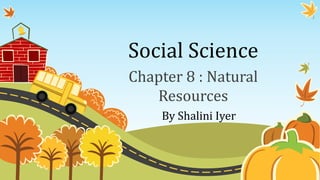
Natural resources.pptx
- 1. Social Science Chapter 8 : Natural Resources By Shalini Iyer
- 2. Uses of Resources • Food • Source of raw material • Source of energy
- 4. • On the basis of Ownership
- 6. On the basis of Distribution
- 7. Resource Planning and Conservation Why is it needed? • Unlimited wants, limited resources. • Population explosion = Increasing demand = excessive use of resources. What it is? • Sustainable development • Gather information and classify • Finding alternative option of limited resources • Strict Law enforcement • Public awareness
- 8. Important Abiotic Resource : Soil
- 10. Soil Formation Bed rocks • Weathering processes Biotic factors • Microorganisms • Plant- roots • Small animals • Insects Abiotic factors • Temperature • Humidity • pH • Air What is soil? Soil can be defined as the organic and inorganic materials on the surface of the earth that provide the medium for plant growth. Soil develops slowly over time and is composed of many different materials.
- 11. Types of Soil 1. Alluvial soil 2. Red Soil 3. Black Soil 4. Laterite Soil 5. Desert Soil 6. Mountain Soil 7. Forest Soil 8. Marshy or Peaty Soil As described by ICAR
- 12. Alluvial Soil • 43% of total area of India • Found in Northern plains and delta regions of Mahanadi, Godavari, Krishna and kaveri • Formed due to deposition of rivers. • Contains more Potash, Phosphoric acid, Limestone and less humus • Suitable for wheat, paddy, sugarcane, jute, cotton, maize etc.
- 13. Red Soil • 19% of total area of India • Found in Tamil nadu, Peninsular region, Bundelkhand and Kutch • Red incolour due to ferric oxide • Does not contains lime, gravel and carbonate • Low levels of magnesium, phosphate, Nitrogen and potash • Suitable for Jowar, groundnuts, potato, wheat, cotton
- 14. Black Soil • 15% of total area of India • Formed due to spreading of Deccan Lava • Found in Maharshtra, Gujarat, Madhya Pradesh, Andhra Pradesh, Karnataka • Contains more amount of iron, lime, calcium, potash, Aluminium and magnesium carbonates. • Fertile, high moisture retaining capacity, develops fissures on drying • Suitable for cotton (Cotton soil), linseed, mustard, groundnut, tobacco
- 15. Laterite Soil • “Later” in latin means brick • Red in colour due to iron oxide • Wet- smooth butter like, Dry- Hard • Found in peninsular plateau • Contains more iron, potash, aluminium • Less fertile soil • Ragi, coffee, sugarcane, cashew can be grown after adding fertilizers
- 16. Desert Soil • Found in arid or semi arid regions • Sandy and infertile • Contains more dissolved minerals • Found in Rajasthan, Harayana, South Punjab, North Gujarat • Millet and Jowar Can be grown by Proper irrigation
- 17. Mountain Soil • Found in valleys and slopes of Himalayas • Altitudes 2700 to 3000 meters • Thin layaered and under-developed • Found in Assam, Darjeeling, Himachal Pradesh, Kashmir • Suitable for pine and chir
- 18. Forest Soil • Found within Altitudes between 3000 to 3100 metres. • Mainly in coniferous forest of Himalayas, Sahyadri, Eastern Ghats and Terai Region • Covered with shedded leaves • Black surface due to rich humus content • Suitable for tea, coffee, spices etc
- 19. Marshy or Peaty Soil • Formed in humid regions due to accumulation of biotic elements • Sumerged in water during monsoon- suitable for paddy cultivation • Rich in biotic elements and minerals • Less phosphate and potash • Found in Odisha, West Bengal, Coast of Tamilnadu, North Bihar, and Almoda region of Uttarakhand
- 20. Soil Erosion • soil erosion refers to the wearing away of a field's topsoil by the natural physical forces of water and wind or through forces associated with farming activities such as tillage. • Leads to loss of fertility
- 21. Methods to Prevent Soil Erosion • Plant trees in Fallow land • Construct Check Dams • Plantation in sloppy regions by contour method • Deep cultivation To reduce the speed of water • Control on grazing activity
- 22. Soil Conservation • Refers to Maintaining soil quality and prevention of erosion • Retaining soil particles at their original place Remedies • Aforestation • Planting trees on slopes and mountains • Shelter belts near deserts to prevent high speed winds • Diverting flow of flood to dry river beds • Horizontal cultivation, Terrace farming
- 23. You May Ask Your Questions Now Thank You